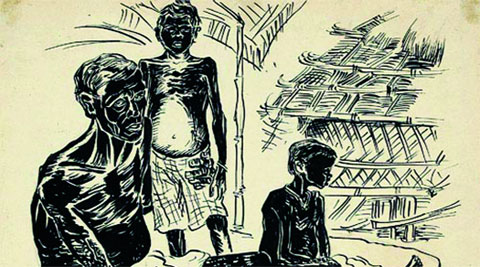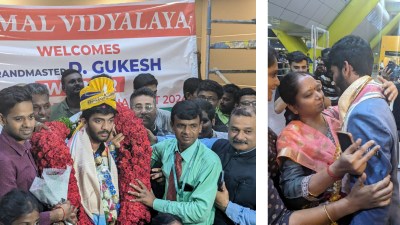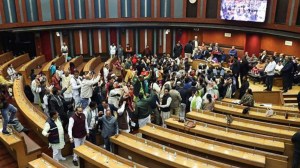- India
- International
An Artist & a Humanitarian
City gallery holds a month-long retrospective of the art of Chittaprosad, known for documenting the Bengal Famine.
 The sketch The Last Family of Telirbaugh, Bikrampur.
The sketch The Last Family of Telirbaugh, Bikrampur.
In 1943, Bengal was hit by what was perhaps the most devastating man-made calamity in history — the Great Bengal Famine. Back then, Chittaprosad, a fairly well-known artist, set out for the famine-hit small towns of Midnapore and Bikrampur on foot. Walking past hundreds of men, women and children — “a procession of the famished, helpless living skeletons” — whose ribs stuck out of shriveled bodies that were covered only in rags, Chittaprosad documented this harrowing experience through detailed sketches and letters.
These, published in a weekly tabloid People’s War, along with his works for children and the Communist Party of India (CPI) will be on display at the Delhi Art Gallery, Kala Ghoda, till August 12 as part of an exhibition, “Chittaprosad: A Rare Retrospective”.
“Chittaprosad was a master artist and his contribution to art is immense, but he was a humanitarian first. His work is a significant part of our art history,” says Kishore Singh, Head of Exhibitions and Publications at the gallery. Chittaprosad’s work based on the Bengal Famine occupies the entire first floor of the gallery.
His sketches of hungry children with sunken stomachs and women selling their bodies for a morsel of food are drawn to chilling accuracy.
One such sketch shows a starving family of a mother and son with the title, The Last Family of Telirbaugh, Bikrampur. “What’s astonishing is that his notes were very comprehensive. He spent time with the people finding out where they came from, how many family members they’d lost, when they’d last eaten and so on,” says Singh.
Chittaprosad’s notes are compiled in a book titled Hungry Bengal, published in 1943 and priced at Rs 3. “Around 5,000 copies of the book were printed, all of which were torched by the British,” says art historian Sanjoy Mallik, who spent seven years researching on the life and work of the artist.

“Only one copy that was with the family has survived. The gallery has acquired it and reproduced it for the show,” he adds. Along with Hungry Bengal, four other books compiled by Mallik have been released. These include Yours Chitta, a collection of letters written to his family and friends from his small flat in Andheri where he spent most of his working years, and a collection of his sketches of 30 Communist leaders.
Another section of the exhibition highlights an interesting part of Chittaprosad’s life — his fondness for children’s books. “Some of his best works are linocuts-on-paper of his Ramayana series and the novel, The Kingdom of Rasagolla and Other Tales,” says Singh. A poster made by the artist for filmmaker Bimal Roy’s Do Bigha Zamin and linocuts of puppets also feature in this section.
“He was introduced to puppetry by Czech artist F Salaba, who gifted him the equipment to start Khelaghar, a puppet theatre,” Singh says.
In spite of being a popular artist in the fifties, Chittaprosad lived in penury till his death in 1978. He lived a simple life, as can be seen in the documentary titled Confession made by Czech filmmaker Pavel Hoble in 1972, which is being screened at the show.
“A man of principles, he refused money from his friends and if someone overpaid him for his work, he would stubbornly return it,” says Mallik. To avoid conformity within the caste system, he dropped his surname, Bhattacharya. A self-taught artist, he belonged to neither the Bengal School of Art nor the Bombay Progressives.
So it was incredible that he made social realism his forte, Mallik adds. In one note Chittaprosad writes, “No one knows it better than me that I am not a genius like Van Gogh. And precisely because I am not, my heart and life lies in the country’s revolutionary struggle.”
According to Mallik, Chittaprosad’s work would never just be the works of a commissioned painter, but of one who responded to the struggles of the society and suffered with them. “Though his work was always appreciated, he never got the recognition he deserved. Through this retrospective, he’s finally getting his due,” Mallik says.
amruta.lakhe@expressindia.com
Apr 25: Latest News
- 01
- 02
- 03
- 04
- 05








































